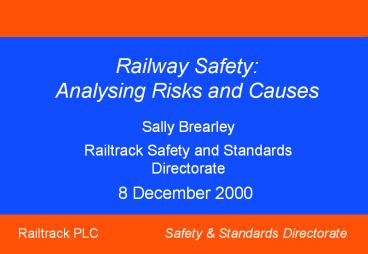Railway%20Safety:%20Analysing%20Risks%20and%20Causes - PowerPoint PPT Presentation
Title:
Railway%20Safety:%20Analysing%20Risks%20and%20Causes
Description:
Stop all the trains, cut off the signalling ... Passengers falling/injured while boarding/alighting from trains ... Model Development ... – PowerPoint PPT presentation
Number of Views:83
Avg rating:3.0/5.0
Title: Railway%20Safety:%20Analysing%20Risks%20and%20Causes
1
Railway SafetyAnalysing Risks and Causes
- Sally Brearley
- Railtrack Safety and Standards Directorate
8 December 2000
2
Stop all the trains, cut off the
signalling Prevent the TOCs from running with
their new plaything Silence the diesels, all the
money is spent SSDs found a hazardous event -
with apologies to WH Auden
3
Agenda
RSC Regs 2000
Safety Decision Framework
Regulatory Framework
Outrage
R2P2
Catastrophic Events
ROTS
Permissioning Regimes
VPF
Ladbroke Grove Public Inquiry
2F
Risk Tools
Europe
SSD Safety Risk Model
Decision Processes
4
Overview
- Role of SSD
- Railway safety cases
- Safety decision framework
- SSDs safety risk model
- Model development
- Risk profiles
- Example of model uses
5
Railtrack SSDs Safety Roles
- Produce Railway Group Safety Plan
- Establish framework for risk control, incl
standards for system safety safe inter-working - Manage Railtracks safety case
- Accept train operators safety cases
- Audit assess safety performance of Railway
Group members - Advice and safety leadership
6
Railway Safety Cases
- Railways safety case cascade is unique
- Railtrack safety case sets out
- nature of operations on infrastructure
- risks arising
- safety management arrangements
- safety decision framework
- Railtrack safety case accepted by HMRI
- Train and station operators safety cases
accepted by Railtrack Safety Standards
Directorate (SSD)
7
RSC Regulations 2000
- SSD becomes Railway Safety
- HSE to accept train and station operators safety
cases also - Single process to facilitate involvement by
Railtrack, Railway Safety and HSE - Safety case cascade broken?
- Interfaces?
8
Railtracks Safety Decision Framework
- Quantitative tolerability levels set for
- workers, passengers, public
- In ALARP region, weigh costs and benefits
- Two Values of Preventing a Fatality
- 1.15m for single fatalities
- 3.22m for multiple fatalities or where risks
close to intolerable - Safety measured in equivalent fatalities
- 1fatality 10 major injuries 200 minor
injuries
9
SSD Safety Risk Model
- System wide risk assessment
- Will underpin Railtracks safety case
- Structured representation of causes and
consequences of potential accidents arising from
the operation maintenance of Railtrack
infrastructure - Exposed populations are
- Passengers
- Workers
- Members of Public
10
Safety Risk Model Scope
- All events that can result in harm to people from
the operation and maintenance of the RCI - Train Accidents (low frequency high consequence)
eg - Collisions
- Derailments
- Movement Accidents eg
- Passengers falling/injured while
boarding/alighting from trains - train-crew struck/crushed by train
- Non-movement Accidents eg
- Slips, trips and falls on platforms
- worker trapped in machinery
11
Hazardous Events and Precursors
- A Hazardous event is an event which has the
potential to lead directly to death or injury, eg
collision - A precursor (cause) is a system or sub system
failure, component failure, human error or
physical effect, which could individually or in
combination with other precursors result in the
occurrence of a hazardous event - Example precursors broken rail, SPAD, dragging
brakes
12
Identification of hazardous events
- Iterative process using 18 generic injury
mechanisms, eg - Electric shock
- Being crushed
- Falling
- Being hit
- Being trapped
- Results of this were then checked against
- Previous studies carried out by the industry
- A review process within SSD
13
Identification of hazardous events
- This iterative process identified 110 hazardous
- events
- These events were then allocated to either
- Train accidents (24)
- Movement accidents (32)
- Non-movement accidents (54)
14
Model Development
- Fault trees of Hazardous Events developed to
level supportable by current data sources - Event Trees for Hazardous Events including
- Different types of track infrastructure
features - Different times of day
- Different passenger loadings
- Other factors which can lead to significantly
different outcomes e.g - Is there a release of toxic or flammable goods?
- Is there a fire?
15
Model Example
16
Development of SRM database
- Project Database that contains records on
- Fault Tree cause precursor data
- Event Tree consequence precursor data
- Event Tree consequence data
- These records contain details
- Assumptions
- Derivations
- References
17
Model outputs
- The model produces
- The frequency of the hazardous event per year
- The risk in terms of equivalent fatalities per
year - Using RiskVu we are able to analyse the models
results to - Identify the risk profile of the hazardous events
- The risk contribution from individual precursors
- The risk contribution from groups of precursors
- Carry out risk sensitivity to changes in data
- Produce F-N curves for the hazardous events
18
Risk profile (equivalent fatalities/year gt1)
19
Risk profile train accidents
20
Risk profile movement accidents
21
Risk profile non - movement accidents
22
Risk profile trespass
23
Example Uses
- The model can be used to respond to questions
such as - What is the risk contribution of track twist to
passenger train derailment? - How much would the overall risk from derailment
increase given a 50 increase in the frequency of
track twists? - What is the current level of risk relating to the
operation of road vehicle level crossings?
24
Where next?
- Risk profile on Railtrack infrastructure
- Risk assessment for Railtracks safety case
- Available to RG members
- Regular risk profile bulletins
- Identify gaps in risk control, sensitivity
analysis, cost benefit assessments - Inform SSD activities Railway Group Safety
Plan, Group Standards audit programme































